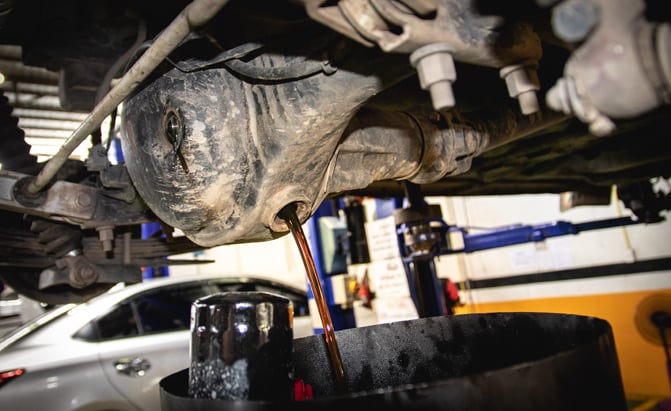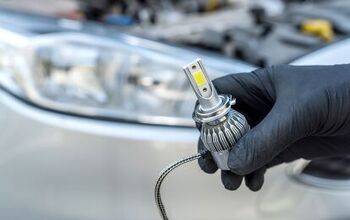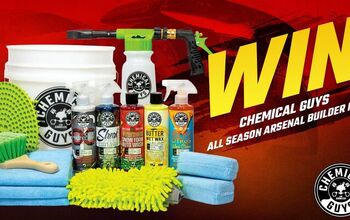The Best Differential Fluids and How and When to Change Them
Your rear differential is one of the most unappreciated parts in your car or truck. It does what might be the hardest job of all of those components, multiplying torque from your transmission and sending it to two rear tires. The whole time, it is letting those two rear tires spin at different speeds. In the case of a limited-slip differential, it’s also making sure power goes to both rear tires. It’s tough work and it’s dirty work and it is why that quart or two of fluid in your rear differential is so important to long life. Here are 5 of the best differential fluids on the market, how to change it, and when to change that rear differential fluid.
A differential is a set of gears and bushings that takes motion in one axis and turns it into another axis while letting two output shafts spin at different speeds. In this case, it takes the driveshaft and sends it to the left and right rear wheels. Because your vehicle turns left and right, the wheels need to spin at different speeds, and the magic bits in your rear diff make that happen. The differential also multiplies torque, that’s the number you hear called a “differential ratio.” Its the ratio of teeth on the ring gear (the output) to the number of teeth on the pinion gear (input). A 4.11:1 differential multiplies torque by 4.11 times what came out of the transmission, which is already multiplied by your transmission from the engine. So a rear differential can see thousands or even tens of thousands of foot-pounds of torque every time you touch the gas.
Differential fluid, also called gear oil, is the fluid that is poured into the rear differential housing. It needs to lubricate the clutches, gears, and bearings in the rear end. It also keeps all of those components cool so that all of the parts in the differential don’t overheat and belt. Limited-slip differential fluids actually have additives that help the clutches in the differential function to stop you from spinning just one tire in the snow or dirt.
Table of contents
- 1. Editor's Choice: Red Line 75W90 GL-5 Gear Oil
- 2. Lucas Synthetic Racing Gear Oil
- 3. Royal Purple Max-GEAR
- 4. Liqui Moly Fully Synthetic Gear Oil
- 5. Mobil 1 Synthetic Gear Lube LS
- How Often Should I Change My Rear Differential Fluid
- How do I Change My Differential Fluid
- Drain Plug Differential
- Closed-Case Differential
- Download the eBay Motors App
1. Editor's Choice: Red Line 75W90 GL-5 Gear Oil
Red Line Synthetic Oil is one of the top companies making synthetic lubricants for all parts of your car. It's a fully synthetic oil that works in thousands of passenger cars and trucks including General Motors, Ford, BMW, and Mercedes-Benz vehicles. Designed for superior shear stability, it won't break down when you're working your truck hard on and off the road. Red Line claims better mileage and less wear thanks to the improved efficiency this oil offers. It also resists oxidation compared with other gear oils, which helps it do its job for the long term. This fluid is meant for use in both limited-slip and open differentials, and it comes with friction modifiers for LDSs meaning that you don't need to add any extra additives for your differential.
Features: Works in limited-slip, offers reduced friction, long-life
2. Lucas Synthetic Racing Gear Oil
Lucas Oil Products were designed for the high demands of the racing world, and that performance translates to helping your vehicle every day. The additive package in Lucas gear oil is designed to cushion your rear-end gears, helping to absorb shock and abuse and protect them from your tough use. It resists being forced out from between the metal parts, even under high temperatures. Lucas says that its gear oil is the go-to for vehicles where other lubricants have failed. Meant for heavy-duty applications, it is also designed to work with limited-slip differentials. Lucas says it safely blends with other synthetic and conventional oils, so you don't need to worry about what's left after a rear differential fluid change. It won't foam or break down, even with the toughest use.
Features: Race-car ready, designed for high-performance applications, helps cushion gears
3. Royal Purple Max-GEAR
More than just its signature dark purple color, Max Gear offers Royal Purple's Synslide additive technology. This is a tough lubricating film that offers maximum protection for your heavily loaded or shock-loaded gears. Think hopping over rocks on the trail. This gear oil reduces wear by increasing the thickness of oil on the gears, keeping them cooler and helping them last longer. Synslide is also designed to displace water from metal if you've gotten some in your rear differential. It eliminates harmful deposits, exceeds MIL gear oil specs, and it meets or exceeds OEM warranty requirements for automotive rear axle lubrication. Max Gear's additives also significantly increase the lubricant's fluidity and lubricity in cold weather climates, helping your car or truck run cooler, quieter, and longer.
Features: Synslide additive package, ideal for cold weather, exceeds OEM requirements
4. Liqui Moly Fully Synthetic Gear Oil
Though not as well known in the U.S., Liqui Moly is one of the leading lubricant companies in Europe, so they know their business. This fully synthetic oil meets GL-5 standards and is designed to ensure exactly the right friction behavior in your rear differential. The company says it can handle large temperature swings and even the most difficult conditions to keep your differential running smoothly. This gear oil will reduce friction and drag and will enhance your gear capacity, and it has excellent viscosity stability, meaning it won't change its characteristics away from its requirements when it gets hot or cold Liqui Moly recommends it for extremely high load applications, though it is not recommended for limited-slip differentials.
Features: Long life, stable viscosity, made to quiet your differential
5. Mobil 1 Synthetic Gear Lube LS
Mobil 1 is one of the best-known lubricant companies in the world, making the factory fill oil for some serious high-performance vehicles. Syn Gear Lube LS is their leading synthetic gear oil, designed for optimal power transfer performance in open and limited-slip differentials. Mobil says that this oil works over a wide range of temperatures, and has a wax-free synthesized hydrocarbon base. That's what allows it to deliver great film strength as well as helping to reduce wear and spalling of your gears under high torque use. Mobil says that it can reduce wear and extend differential life because it forms minimal deposits. The oil is highly resistant to foaming, ensuring it is flowing properly and sticking to your gears. It can also help reduce startup wear even at arctic temperatures.
Features: Highly resistant to foaming, outstanding performance against high torque, can improve fuel efficiency
How Often Should I Change My Rear Differential Fluid
Your owner's manual is the best place to look for your fluid change intervals, as well as making sure you order the correct viscosity, quantity, and type of gear oil. Still, there are some good guidelines and some other situations you should keep in mind.
Most manufacturers recommend changing your rear differential fluid every 30-60,000 miles, and for a daily-driven car or truck that isn't driven to extremes, that's likely fine. If you're using your vehicle in tougher conditions, like regular high-payload hauling, towing, off-road driving, or any sort of motorsports events like a lapping day, then you should stick to the 30,000-mile mark. In those conditions, consider changing it annually or every other year.
Another concern is water ingress. If your differential has a leak that lets fluid out, it can let water in in heavy rain or deep puddles. Likewise, if you are driving off-road and drive through water that is deeper than your axles, water can get in. Especially if you have a vent tube that is still in the stock location. Any time you drive through water, at least before coming home from that off-road trip, checking your rear differential fluid is a good idea. If there is water, you'll need to change the fluid as water will not lubricate your metal parts.
How do I Change My Differential Fluid
When it comes to changing the differential fluid, there are two types of differentials. The first, and the easier to change, has a fill plug at the top and a drain plug at the bottom. The second requires you to remove the cover.
If you're changing the fluid in a truck or tall SUV, you can probably change the fluid without lifting the vehicle. If you can't, make sure you lift the front and rear of your ride to the same height, otherwise, you will not get all of the fluid out or get the right amount of fluid in.
Drain Plug Differential
The first step here is to clean the areas around the drain (bottom) and fill (top) plugs. You don't want any dirt getting into the housing with your fresh fluid. The second step is to open the fill plug, and not the drain. Why? Because if you can't open the fill, then it's better to find that out when your vehicle can still be driven and not when the differential is empty.
After you remove the fill plug, remove the drain plug and use a pan to catch the old fluid. Old gear oil smells horrible, so you might want to do this outside.
Once the differential is empty, put the drain plug back in and torque it properly. If it has a washer, make sure that you replace that washer, it will help prevent leaks. Then fill the differential. Some have enough clearance that you can use the bottle to pour, but others will require a differential fluid pump.
To know where the fill line is on your vehicle, check the manual, but full is often when fluid starts to drip out of the opening. Don't over-fill, though, you'll turn your differential into a blender for the fluid.
Insert the fill plug, changing the washer if required.
Closed-Case Differential
For these differentials, you'll need to remove the entire rear housing. It's messy, and it takes more work because you have to re-seal the cover. Again, remove the fill plug first. Loosen all of the differential bolts. You can remove the lower bolts, but leave the top ones with some slack.
The differential may start to drain as soon as you loosen the lower bolts, but it also may stick. If it sticks, pry gently with a flat screwdriver, being careful not to bend the flange. Let it drain then remove the cover.
Wipe out the cover and inside of the housing to get rid of any old fluid and metal particles. Then use a razor scraper or light abrasive pad to clean the mating surface of the housing and the cover. Wipe and clean with brake cleaner or similar.
Some vehicles use a gasket, others require a gasket material, which is a type of silicone adhesive that's designed to keep the oil inside. Lay a single bead around the cover and around each hole (thicker isn't always better), then bolt the cover in place. Let the gasket maker dry according to the directions and tighten the cover to your ride's specs. Don't overtighten.
Once you're done, fill the differential and put the plug back in. Torque to spec, check for leaks, and you're good to go for another few years.
Download the eBay Motors App
To make life easier when it comes to getting everything you need for your car or truck, consider downloading the eBay Motors App.
More than just a parts catalog app, the eBay Motors app gives you access to one of the largest selections of parts and accessories in the world. You can also buy and sell vehicles and connect directly with automotive enthusiasts right from your phone.
Take advantage of the My Garage feature to easily store your vehicle’s specs so you can quickly find and buy the parts you want. You can store multiple vehicles in your profile, which means you don’t have to re-input the same information every time you use the app. Plus, eBay’s fitment feature ensures you will find the parts that will fit your vehicle.
Another great feature on the app for vehicle sellers is the ability to upload a picture of your license plate, which eBay then uses to grab all the pertinent details of your vehicle for selling, including uploading your VIN number.
Download the eBay Motors app today.
We are committed to finding, researching, and recommending the best products. We earn commissions from purchases you make using the retail links in our product reviews. Learn more about how this works.
Photo credit: Panudet Srichan / Shutterstock.com
Evan moved from engineering to automotive journalism 10 years ago (it turns out cars are more interesting than fibreglass pipes), but has been following the auto industry for his entire life. Evan is an award-winning automotive writer and photographer and is the current President of the Automobile Journalists Association of Canada. You'll find him behind his keyboard, behind the wheel, or complaining that tiny sports cars are too small for his XXXL frame.
More by Evan Williams





































Comments
Join the conversation
You're correct Ryan, the synthetic is hyped for differentials. When the only thing you need to pay attention to is GL-5 rating and limited slip additives if needed.
I agree with Mr.Pratt because I have been searching for hours on just what to run in rear differential on a manual 5 speed I've had for about 15 years and I've decided to go conventional GL-5 is just fine for my conditions.Sure synthetic will give you piece of mind for a price.